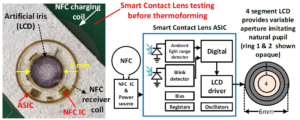
EDACafe Editorial Roberto Frazzoli
Roberto Frazzoli is a contributing editor to EDACafe. His interests as a technology journalist focus on the semiconductor ecosystem in all its aspects. Roberto started covering electronics in 1987. His weekly contribution to EDACafe started in early 2019. SMIC news; 16Gb LPDDR5 DRAM; new approach to AI acceleration; artificial iris; VPN adoption rankingSeptember 7th, 2020 by Roberto Frazzoli
U.S.-China trade tensions are again making news this week, but there is no shortage of other updates. Among them, the introduction of the new Arm Cortex-R82, a 64-bit, Linux-capable processor targeted at next-generation enterprise and computational storage solutions It provides up to 2x performance uplift compared to previous Cortex-R generations, depending on the workload. Let’s now move to more weekly news updates. U.S. Government reportedly considering whether to add SMIC to a blacklist According to news agency Reuters, the Trump administration is considering whether to add Chinese foundry SMIC to a trade blacklist of companies, which would force U.S. suppliers of semiconductor manufacturing equipment to seek a license before shipping to the company. Reportedly, U.S. Government agencies are investigating to assess if SMIC has a relationship to the Chinese military. SMIC has responded to these media reports with a press release declaring that “the Company manufactures semiconductors and provides services solely for civilian and commercial end-users and end-uses. We have no relationship with the Chinese military. In and before 2016, SMIC had been granted Validated End-User (VEU) authorization by the BIS (Bureau of Industry and Security) and the company hosted several visits from U.S. Government officials. Any assumptions of the Company’s ties with the Chinese military are untrue statements and false accusations.” The SMIC statement concludes by declaring that “The Company is in complete shock and perplexity to the news. Nevertheless, SMIC is open to sincere and transparent communication with the U.S. Government agencies in hope of resolving potential misunderstandings.” Samsung begins mass production of 16Gb LPDDR5 mobile DRAM Samsung’s second production line in Pyeongtaek, Korea, has recently commenced mass production of the industry’s first 16-gigabit LPDDR5 mobile DRAM, using extreme ultraviolet technology. According to Samsung, at 6,400 megabits per second, the new LPDDR5 is about 16 percent faster than the 12Gb LPDDR5 found in most of today’s flagship mobile devices. When made into a 16GB package, the LPDDR5 can transfer about 10 5GB-sized full-HD movies in one second. Improvements also include the device package, which is 30 percent thinner than its predecessor. The Korean company will also expand the use of its LPDDR5 offerings into automotive applications. Samsung’s Pyeongtaek Line 2 is the world’s largest semiconductor production line to date. SimpleMachines’ new computation paradigm Over the past few years, the success of neural networks has uncorked a plethora of new processing architectures targeted at accelerator chips – each of them, of course, being advertised as unique. Now a startup called SimpleMachines (San Jose, CA) is questioning the approach on which domain-specific accelerators (DSAs) are based and is proposing a new computation paradigm. Here is how the company describes its three key findings: “1: DSAs and custom-chips are unnecessarily specialized. Regardless of what problem they are solving, across the board, their designs reuse the same set of fundamental ideas. 2: These fundamental ideas can be formally defined as program behaviors and can be paired with corresponding efficient hardware implementation. 3: These particular behaviors can be succinctly and formally defined, allowing compiler tools, computer architects, and chip designers to build upon them and create solutions that are programmable, yet as efficient as custom-designed chips.” According to SimpleMachines, current DSAs sacrifice programmability to gain efficiency improvements, a high price to pay. As the startup maintains in a white paper, “First, this makes DSAs prone to rapid obsoletion: the domains and algorithms which require specialization are constantly evolving due to scientific progress and changing user needs. Second, the needs of the relevant domains typically migrate across different device types (server, mobile, wearable, etc.). Supporting each device type by creating fundamentally new designs costs both design and validation time. Finally, most business deployments must run several different workloads to support their business objectives, thereby requiring a jumbled integration of many such custom designs.” To overcome these limitations, the startup is developing a new chip based on a paradigm called Composable Behaviors. As recently announced by Mentor, SimpleMachines has successfully validated, verified and demonstrated its initial device – one year before availability of first silicon – using Mentor’s Enterprise Verification Platform and Mentor Consulting’s cloud-based Emulation-as-a-Service (EaaS) offering. Contact lenses get LCD-based artificial iris to change pupil size Belgian research center Imec and Ghent University (Ghent, Belgium) have presented an artificial iris embedded in a smart contact lens. The iris aperture is tunable through concentric rings on an integrated liquid crystal display (LCD). The smart contact lens is designed to operate for an entire day thanks to an ultra-low power design, offering a practical solution for people who suffer from human eye iris deficiencies like aniridia, high order aberrations like keratoconus, and light sensitivity or photophobia. Compared to current solutions that cannot dynamically change the pupil size, the new contact lens brings back two important functionalities of the eye: light adaptation and expanded depth-of-focus.  Left: photograph of the smart contact lens solution; right: top level block diagram Arabian Peninsula leads the world ranking of VPN adoption According to a research from Atlas VPN, a Virtual Private Network provider, countries of the Arabian Peninsula lead the world ranking of VPN adoption. The top five places are occupied by United Arab Emirates, Qatar, Oman, Saudi Arabia, and Kuwait. Topping the list with a penetration rate of 38.72% is UAE, meaning that VPN in that country is used by 1 people out of 2.58. The research team analyzed and ranked 85 countries, calculating the VPN penetration rate by summing up VPN downloads by country and dividing it by the country’s population. The VPN download data was extracted from Google Play Store and Apple App Store using the Sensor Tower service. Download data includes 45 biggest VPN providers. Acquisitions Allegro MicroSystems has acquired Voxtel (Beaverton, Oregon), a privately held company specializing in advanced photonic and 3D imaging technology including long-range, eye-safe LiDAR. With this move, Allegro hopes to increase its foothold in the car of the future – especially in the next generation of Advanced Driver Assistance Systems – by combining its portfolio of components used in the transmit and receive blocks of automotive LiDAR systems (motor drivers, position sensors, regulators, and current sensors) with Voxtel photonics. |
|
|
|||||
|
|
|||||
|
|||||








